Skiing in Zermatt
Each of Zermatt’s three ski areas amounts to a resort in its own right in terms of quantity and variety of terrain, and then there is Cervinia and Valtournenche as well. Quite simply this is one of the best ski areas in the world with 360km of piste skiing and extensive off-piste.
Zermatt Ski Area Overview
You could waste a lot of time and space discussing how extensive and distinctive Zermatt’s skiing is, so here goes: wherever you compare it with, Zermatt is one of the world’s best ski resorts, not merely in terms of piste extent, variety and challenge but for the setting. The nature of a day in Zermatt, on or off-piste, is a journey through stunning mountains. Thanks to sympathetic development and the physical limitations imposed by the huge glaciers descending from the surrounding peaks, the ski area retains a wild feel; for a major ski resort, the landscape is barely touched.
Zermatt sits at 1,620 m within the Pennine Alps, a mountain chain that stretches from the Grand Combin in the west to the cluster of 4,000 m peaks which form the Monte Rosa massif to the east. The village marks the end of a narrow valley, and is bounded by three integrated ski areas each reaching over 3,000 m: to the south, forming the watershed between Switzerland and Italy, is the Matterhorn Glacier Paradise (Klein Matterhorn) region with huge glaciers at altitude and snow-sure north-facing slopes stretching 2,200 vertical metres down to the village; to the west, high mountains rise steeply, remaining unskied other than by heli-skiers and ski mountaineers; to the east, on gentler but still massive slopes, are the two other areas, Blauherd-Rothorn and Stockhorn-Gornergrat, the latter still accessed from the heart of the village by the cog railway which first opened in 1898.
The skiing is best described following the order in which you most easily cover the three ski areas, linking one with another in a clockwise tour. Keep in mind that each area amounts to a resort in its own right, in terms of quantity and variety of terrain, uplift, restaurants and other facilities; those in the know often advise skiing just one ski area each day rather than trying to link them, but it’s fair to say the different areas are much better connected now, so it’s easier to switch from one area to another.
Blauherd/Rothorn
This single mountain has it all: beginner skiing, intermediate cruising and off-piste challenge, as well as what are regarded as the best mountain restaurants in the world. From the top of the Rothorn there are broad, fast red runs, long cruisers around mid-mountain, off-piste itineraries and tree-skiing on the lower third down of the mountain to the village; throw in the restaurants at Findeln and you might not feel the need to venture further.
First stop out of the village is Sunnega, a main ski school meeting place accessed by a fast underground funicular train. A gondola takes you on to Blauherd, followed by a cable car up to the Rothorn from where several itineraries and a red run take you down the west side of the mountain. In the other direction, a long red run traces its way over south-facing slopes to Gant, for access to the Stockhorn and Gornergrat, and onwards to the biggest area of all, the Matterhorn Glacier Paradise (Klein Matterhorn) and the neighouring Italian resort of Cervinia to the south. When on the Rothorn, don’t miss the last run of the day: one huge descent, top to bottom, with a pit-stop at Tuftern to catch the last of the sun dropping behind the Matterhorn – long after the village is overtaken by shadow.
Stockhorn/Gornergrat
The yin and yang of Zermatt on one mountain: a smooth cruise on the west face and the toughest, biggest freeriding to the north. The slow train ride from the centre of the village to the observatory, hotel and restaurant at the top of the Gornergrat, overlooking the Gorner and Grenz glaciers, reflects the skiing on the west side – relaxed, with a truly stunning view of Monte Rosa, Lyskamm and Breithorn among other peaks working their way towards the Matterhorn. The train is not fast but it keeps to its well publicised timetable and it gets you to over 3,000m in about the same time as it would take to queue for then ride two or three different bubble and chair lifts. But if you don’t like the idea of a steady chug up the mountain, or if you are staying in Zermatt at the Klein Matterhorn end of the village, you can take the lift from Furi instead.
It is almost entirely intermediate terrain, brought up to date when the comfortable Gifthittli six-seater chair replaced an old T-bar. With several pistes tracing their way back to its base you can spend all day here, basking on west-facing slopes with some of the best views of the Matterhorn in the entire resort. There’s similarly gentle skiing winding the length of the cog railway, punctuated by bars, mountain restaurants and the luxury Riffelalp Resort.
Heading onwardsv via Hohtalli and Rote Nase to Stockhorn takes you from the sublime to the ridiculous: over one thousand vertical metres of high altitude freeriding terrain and one of the steepest, broadest, longest mogul slopes – just under 1,200 vertical metres – you are ever likely to encounter. This area can be reached from the Gornergrat by the Hohtalli cable car – a slow process – but is better accessed from the Rothorn. Stockhorn itself is often closed until mid-February because it takes time for the snow to accumulate,
Matterhorn Glacier Paradise
The Matterhorn Glacier Paradise (Klein Matterhorn) is the biggest ski area in Zermatt’s constellation, from 3,880 m down to the village at 1,620 m. Not only is it a huge vertical drop, but the distance, on or off-piste, is enormous too. Ten miles from top to bottom is the shortest way down by piste. Take it in one and you might never walk again! From the top of the Klein Matterhorn is a 360-degree panorama – beyond Mont Blanc to the west and the rest of the Alps to the east – and snowsure, expansive ski area. The snowfields at the top are home to Zermatt’s snowpark. Down below, beneath Schwarzsee, there’s also some of Zermatt’s best tree-skiing.
Direct access is from the southern end of Zermatt, via Furi and on to Trockner Steg or Schwarzsee. Crossing from the Gornergrat to Furi reveals the weakest link in the chain if you’re trying to ski the region as a whole. An 8-seat gondola runs from Furi to Riffelberg (with an intermediate station) and provides the missing connection between the Klein Matterhorn and Gornergrat sections of the mountain. A new summit lift takes you directly from the station to an observation platform at 3883 m, where you can enjoy the panorama of peaks in Italy, France and Switzerland towering above.
The Glacier restaurant at Matterhorn Glacier Park, with seating for up to 120 people, accommodation for 40 climbers and a vantage window facing the Breithorn (4,164 m), opened in 2008. A special sewage treatment facility, the highest in the Alps, ensures waste water is purified in an environmentally friendly way. The front of the building is equipped with solar panels, which at this altitude generate nearly twice the amount of energy as the same size solar panels in lowland areas. Solar energy is stored for heating the building, and no external energy supply is required.
Matterhorn and Breithorn
Zermatt’s highest terrain spans the area between the 4,164 m Breithorn to the east and the 4,477 m Matterhorn to the west. The vast Theodul and Furgg glaciers cap the relatively flat, broad col over which the Italian resort of Cervinia is reached. Staying on the northern side, a high traverse brings you under the Matterhorn’s east face for a close-up encounter with this noble monster. A more direct descent to where the glaciers end and the real skiing begins – exceptional red runs, wide, steep enough for interest and almost always well covered in chalky, dry snow – leads to the Schwarzsee link. From there you are soon into the treeline and different skiing once again. Given the mileage you will have covered just to get here, the excellent mountain restaurants at Furi are as much necessity as they are luxury.
Zermatt Ski Area Connections
The opportunity to cover big mileage is one of the key aspects of Zermatt’s skiing, but it’s worth knowing that not all connecting runs are created equal: Rothorn to Gant is long and varied, whereas the Stockhorn side is best skied as is now intended, as a freeride area. Following the ‘White Hare’ red run from Hohtalli for the sake of skiing that side of the mountain, or simply heading for the Rothorn via Gant may well be disappointing – the top section is narrow, relatively steep and rapidly scraped to hardpack by skiers avoiding the various off-piste routes. And it is likely to be in its worst condition just when the freeriding isn’t inviting either – better to stay away at these times; it’s not a problem as the route from Rothorn to Matterhorn via the Gornergrat area can still be skied without having to descend this side at all. In any event, the Stockhorn usually only opens at the end of January as the steep, rocky and partly glaciated terrain requires a substantial accumulation of snow to be safely skied.
Guaranteed snow cover in Zermatt
Zermatt is one of only two ski resorts worldwide offering skiing and boarding 365 days a year and is one of the most snow sure resorts in the Alps with more than 70 per cent of Zermatt’s pistes benefiting from artificial snow-making or on glaciers. Across the border in Italy, around 50 per cent of Cervinia pistes can be covered with artificial snow, and the Matterhorn ski paradise (Zermatt, Valtournench and Cervinia) as a whole can guarantee snow cover on over 200km of pistes.
Beginner Skiing in Zermatt
Although beginners in Zermatt get to experience the magnificent mountain atmosphere, they have to get up there – and whether a novice or improving beginner reaching the ski area and the glaciers is a chore compared to most other ski resorts.
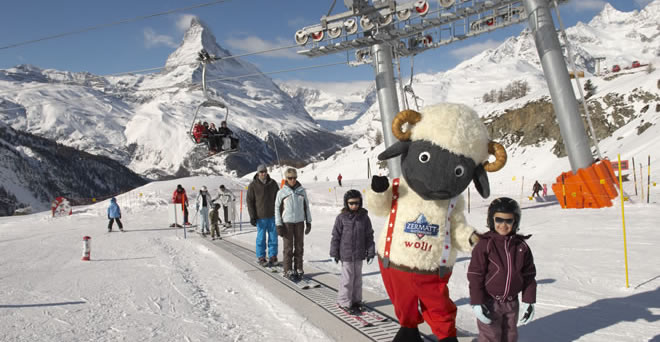
Beginners are the only losers in Zermatt, though even that’s merely in relative terms: there are good slopes on which to learn, including Wolli Park for novices and long gentle runs on the glaciers. Snow is never a problem, but novices and timid intermediates in Zermatt will miss out on a range of ski experiences that require sufficient skills to travel the slopes efficiently.
And though beginners will still get to experience Zermatt’s magnificent mountain atmosphere, they have to get up there, and reaching the glaciers by a series of busy cable cars, for instance, is a chore which won’t be appreciated without the reward of a huge descent.
Logically, novices should ideally choose to go to another resort, though beginners within a mixed-ability group will be well enough served as long as they accept that there will be whole swathes of the ski area that they won’t visit. Sunnegga, Blauherd and Trockener Steg are the main ski school meeting points and, along with the Gornergrat, these are where the best blue slopes can be found.
Improvements include the new vertical Leisee Shuttle lift providing first time beginners with easy access from the top of the Sunnega funicular lift down to the Wolli Park – a dedicated nursery area at Findeln, with four magic carpet conveyor lifts and a range of play equipment for children.
The Wolli Park lift pass costs 50% less than the full Zermatt ski lift pass and includes uplift from the village (1,620 m) to Sunegga (2,288 m) via the funicular, the Leisee Shuttle, Eisfluh, Findelbahn and the magic carpets in Wolli Park.
With as many as five main ski schools for group instruction in skiing and boarding in Zermatt and three private ski schools, beginners have plenty of ski schools to choose from and invariably all of Zermatt’s ski sintructors speak good English.
Ski Schools & Ski Lessons in Zermatt
Looking for private or group ski lessons? CheckYeti works with leading ski schools and ski instructors in over 500 ski destinations throughout Austria, France, Germany, Italy and Switzerland. Let them help you choose the right ski school or instructor for you. Qualified and experienced ski instructors and guides at 500+ ski destinations, 6,000+ offers and 24,000+ ski school reviews. View ski schools, classes, offers and discounts, and pre-book your ski lessons online.
Book Ski School Lessons in Zermatt Online >
Intermediate Skiing in Zermatt
Red runs account for over 60% of Zermatt’s extensive piste skiing and strong intermediates have the most fun as they can link Zermatt’s areas together and also enjoy a day trip to Cervinia on the Italian side of the Matterhorn.
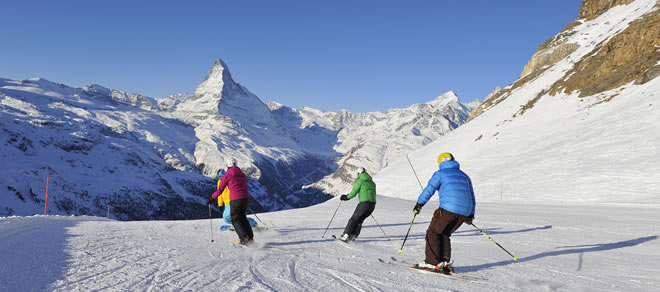
For the biggest category of skiers Zermatt has plenty to offer. Strong intermediates – in terms of technique and fitness – have the most fun as they can link the resort’s ski areas together and also enjoy a day trip to Cervinia on the Italian side. Though most of the runs marked on the piste map are red, many of these routes are broad as well as long, giving weaker skiers the opportunity to traverse out of trouble and take their time. Crowded bottlenecks on piste are the exception other than in highest season, though that may change as Zermatt’s ski lifts continue to increase in capacity and push up skier density.
The Rothorn offers top-to-bottom routes that can be tackled by most skiers, offering the kind of away-from-it-all ski experience that normally remains the preserve of advanced skiers. The long Kumme run down to Tuftern continues by a blue track through the trees right back to the village, passing cafes and restaurants in the bottom half. The connecting run to Gant gives even more sense of a journey, through varied, winding terrain, though staying above the treeline. A useful pit stop is the Flualp restaurant a third of the way down, with views across the Findel glacier, the north face of the Stockhorn and across to the Matterhorn. Below Blauherd and Sunnegga are forest glades and multiple routes back down to village level. In good snow conditions and on colder or windy days, when the top of the mountain doesn’t appeal, this is the place to be, with easy access back to the village or to a range of mountain restaurants.
Avoid the Stockhorn/Hohtalli area unless you’re confident on steep terrain, and concentrate on the Gornergrat instead. The blue pistes running either side of the six-seat Gifthittli chairlift bask in afternoon sun but retain exceptional snow – the base is over 2,500 m (8,202 ft). This is ideal cruising territory, good for a blast on rolling, well-groomed and often deserted terrain. Following the railway all the way back to base is another big journey, with both easy intermediate and slightly tougher options, as well as the onward route via Furi to link with the Klein Matterhorn (“Matterhorn Glacier Paradise”). The new gondola between Furi and Riffelberg dramatically improves the link.
The Matterhorn Glacier Paradise (Klein Matterhorn) extensive terrain is bliss for intermediates. Once again, there’s a chance for skiers to experience the kind of high-mountain terrain that often means a serious descent in other resorts. Here it’s the length of the route home that’s serious: 16km is the shortest way down by piste. Up high, the snow is invariably good, though the long flat section under the Theodulhorn needs a massive run-up to avoid a slow pole-push finish; it’s certainly one to avoid on a board or into a headwind.
The Furggsattel six-seater (which starts in Switzerland and deposits you in Italy) was a sensational improvement over the T-bars it replaced, giving quicker and more comfortable access to perfect carving pistes as well as to the Matterhornpiste – the start of yet another big journey, via Furgg and Schwarzsee, beneath the north-east ridge of the Matterhorn and down, at last, to Furi. More challenging are the direct routes to Furgg from Trockner Steg and the Furggsattel – still wide open, but with bumps usually developing, and mixed, rolling and at times quite steep terrain.
Advanced & Expert Skiing in Zermatt
Zermatt has its fair share of challenging black runs, but Stockhorn is Zermatt’s experts’ playground, and in good conditions with probably more powder than you can handle. There are also a number of marked off-piste itineraries and extensive freeriding outside the main ski area.
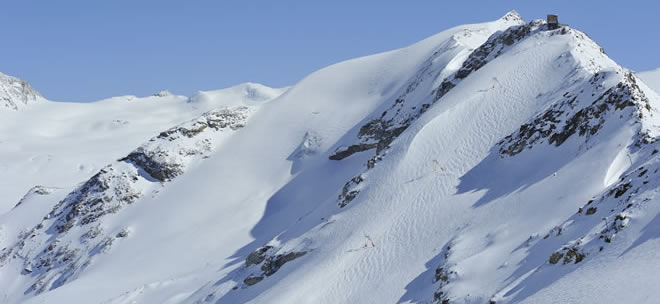
Don’t be misled by the apparent lack of black runs on the piste map. Plenty of Zermatt’s red runs are of a scale and diversity that make them well worth your time. For tougher stuff, Zermatt has introduced off-piste itineraries: marked in orange on the map, these are not groomed and should be undertaken only by appropriately equipped, competent skiers, taking current avalanche conditions into account. These ski itineraries offer a classic off-piste experience after recent snowfall and for many skiers are best visited with one of Zermatt’s mountain guides.
From the top of the Rothorn, two itineraries are reached by cutting high and over a ridge onto the west face of the Unterrothorn, to lead down towards Tuftern. The face is a consistent pitch, with multiple rocky gullies. It catches a lot of wind, often leaving pockets of sublime snow flanked by bony ribs. Back on piste, the top of the ‘National’ black run from Blauherd to Patrullarve is a fast ride down into the trees. Much of it can be skied to either side, ducking into tight trees; alternatively, the ‘rock garden’ directly under the Patrullarve chairlift gives a great line into excellent tree-skiing, but needs plenty of snow if you value your skis.
The Stockhorn is the supreme HQ for Zermatt’s experts. It usually opens in late January when sufficient snowfall has accumulated to fill crevasses and cover rocks. The main Stockhorn face is a steep, sustained bump run through Triftji of eleven hundred vertical metres; after fresh snowfall, if you like powder-covered bumps, this is the ultimate. To either side are enormous tracts of freeride terrain. The area is north-facing, and so steep that the snow stays in good condition almost indefinitely. To skier’s right of the central slope, reached either by hiking the ridge from the lift top or by cutting under the lift and traversing below the cliffs, there are endless ways down. But care is needed: there are crevasses as well as the potential for avalanche. The further right you go, the longer the traverse out at the bottom, though only the final section flattens off enough to be an issue in fresh snow.
The circuitous round trip, via a minimum of two lifts, is the only thing between you and more powder than you can handle. The rest of the face, from either the Rote Nase draglift or the Hohtalli cable car, covers a huge area, with most of it up for grabs. Crevasse danger is not an issue, but the bowls and gullies are punctuated by rocky outcrops and small cliffs that leave you in no doubt about the level of skiing involved; for all but experienced off-piste skiers this is guide territory. Skiier’s left of Hohtalli gives yet more routes down to Gant or to the restaurant at Grunsee and on to Findeln. These routes can also be picked up by hiking the ridge from the Gornergrat.
The top of the Klein Matterhorn area and Cervinia offers relatively little real challenge, but plenty of temptation: the powder is often perfect beyond the ropes but you take your chances with crevasses. On the pisted areas they are filled each summer by bulldozers; beyond the boundaries they sometimes claim snowboarders who have tried to backtrack out of a tricky line by taking off their boards and walking. Without the support of the board they easily drop through thin snow bridges. Skiers are vulnerable too, particularly in a bad snow year, or simply by stopping or falling in the wrong place.
Where the mountain steepens lower down, a couple of itineraries head towards Furgg, while beneath Schwarzsee two main itineraries – the Tiefbach and the Momatt – drop off the shoulder through tree-lined riflebarrel gullies and a black run descends from Aroleid to Furi. It’s a more rewarding experience than the twisty Furgg-to-Furi black run, frequently hard-scraped by the descending hordes who want to ski all the way home on the last run of the day, regardless of their ability. Higher up and almost always deserted, with a covering of fresh-blown snow, is the short, sharp black run from the Hornli lift, a T-bar with a wind-blasted double-black diamond finish.
Ski Touring & Heli-Skiing in Zermatt
The mountain guides at Zermatt’s Alpine Center offers a comprehensive programme of off-piste training, guided itineraries and day tours as well as heli-skiing. Beyond the in-bounds off-piste itineraries are more day tours than you will have days in your week, many of them involving high-altitude peak-bagging. They are best left towards the end of your stay – when you’re acclimatised to the altitude – and are only for fit and adventurous skiers.
Notable for a lack of climbing – more a long traverse – and some of the best skiing in the whole region, is the Schwarztor, a 3,731 m col on the far side of the Breithorn. A huge, steep descent of the Schwarze glacier brings you onto a broad, flat section of the Gorner glacier and back to Zermatt. Depending on the state of the snow, there’s a more or less sporting drop from the snout of the glacier, deep in a rock cleft, which involves sliding down a rudimentary fixed rope. One way or another you can be sure of a day you’ll never forget.
Other peaks on the Alpine Center’s regular day tour list include: Pfulwe, Cima di Jazzi, Fluhhorn, Fillarhorn and the Breithorn. These are mostly well over 3,000 m, but by using the nearest, highest lift access, most ‘only’ involve around two hours’ climbing on skins, followed by long descents – in some cases to Tasch, one village down the valley from Zermatt. For guided off-piste skiing not on this list, guides must be booked individually, so going with a group is helpful to spread costs. The only ‘turn- up-and-go’ groups are the tours.
Guided heli-ski drops are made on the Alphubeljoch (descending either to Tasch or Saas-Fee), Monte Rosa, Aschihorn, Testa Grigia and the Rothorn, giving vertical drops of up to 2,600 vertical metres.
Boarding & Freestyle in Zermatt
Zermatt has plenty of terrain to excite serious boarders, including big and thorough snow parks such as the year-round Gravity Park.
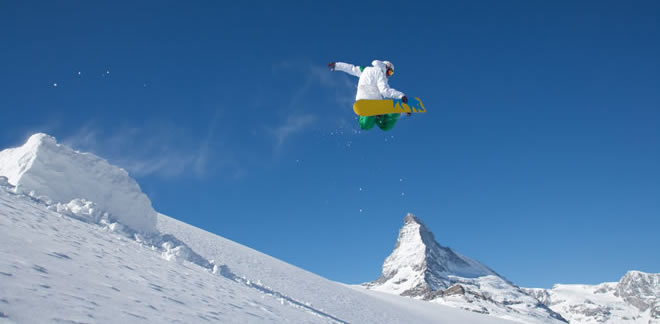
Flats and traverses in Zermatt are not a huge problem when balanced by the incredible off-piste riding, but avoid the Plateau Rose glacier and the Weisse Perle below Schwarzsee. The carving area below Furgsattel is served by a fairly recent chair and the lift system in general is boarder-friendly.
Specific facilities are typically big and thorough: above Trockener Steg below the Gandegg chairlift is the Gravity Park (the venue for the Swiss Snowboard Championships) with halfpipes, kickers and rails, and also a ski/boarder-cross course. From July to November it moves up the mountain, to just above the lift; Stoked Snowboard School runs summer camps in July and August. There’s also a snowcross course and mini park at Blauherd.
Mountain Restaurants in Zermatt
Zermatt’s mountain restaurants are blessed with a winning combination of great cuisine, majestic views and the authentic feel of charmingly restored alpine farm buildings, and regarded by many as the best mountain restaurants in the world.
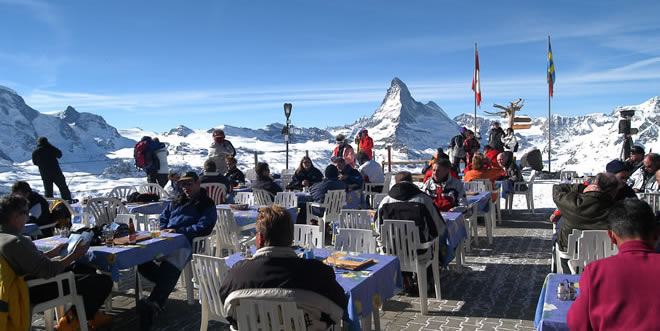
This is the point of coming to Zermatt, maybe even the reason to learn to ski in the first place. Hard to believe there are more than 50 huts and mountain restaurants, many of them famous for great cuisine, some even with Gault Millau points. Throw in the views (not just of the Matterhorn, but it’s a good starting point) and the authentic feel of many of the restaurants – charmingly restored alpine farm buildings – and you’re onto a winner.
There’s a range of food that includes traditional Swiss dishes, including the cheesy ones, but it’s worth seeking out menus featuring the local fauna and flora. Lunching on the old terrace at Franz & Heidi’s (Findlerhof) on a sunny day with the Matterhorn rising majestically as if from the end of the deck, the hubbub and the delicious food and wine are an intoxicating mix. The real wonder is that comparable experiences can be had in huts across Zermatt’s entire ski area. These typically offer well prepared traditional Walliser specialities (lots of home-made soups, cheese plates, salads, breads and cured meats) as well as wonderful bratwurst, rösti and special pasta dishes, the last reflecting the influence – just across the peaks – of Italy.
Some other excellent huts you might try (by no means exclusively) are the Paradies, also at Findeln, both the Zum See and Blatten restaurants in the eponymous hamlets below Furi, the Fluhalp, just below Unter Rothorn at over 3000 metres, which often has live music on sunny days, and the famous Simi’s at Furi. Also at over 3000 metres, you shouldn’t miss the charming Gandegghűtte, above Trockener Steg, which has been going since 1885. And if Zermatt ever runs out (impossible) you can always ski over to Cervinia for some genuine Italian food. Be sure to book unless eating very early or late.
Ten of the Best Mountain Restaurants in Zermatt
Here’s our pick of ten of the best mountain restaurants in Zermatt, an eclectic mix based on quality, geography, charm and sheer fun.
Findlerhof
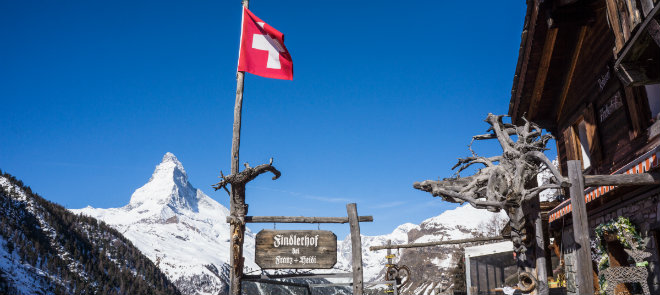
Still number one in our view and rightly so for the combination of all that makes lunching an unforgettable experience in Zermatt. Tucked away at furthest accessible extent at the bottom of Findeln, amongst some old wooden sheds, down a roped path, you come upon this half-hidden gem. Ski carefully as you approach for fear of missing Franz and Heidi Schwery’s lovely ancient mountain hut. They serve traditional Swiss cooking, Walliserteller and modern Italian dishes along with the best salads. The food is simply mouth-wateringly good. An excellent wine list contains a large Italian offering, carefully selected by Franz. Inside or out though, Findlerhof is all about ambiance and the charm of old Zermatt.
Tel: +41 27 967 25 88, Email: info@findlerhof, Web: www.findlerhof.ch
Zum See
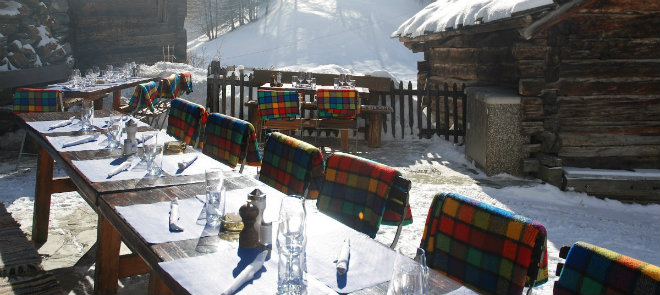
Skiing down below Furgg, steep below the Matterhorn on the way back to Zermatt through some woods, you will come on a collection of black timber houses and farmsheds from another century. This is the hamlet of Zum See, after which this famous mountain restaurant names itself. Max and Greti Mannig offer more old Zermatt charm, whether outside on the terrace on a sunny day or in the lovely old dining room. Swiss cooking dominates a fine menu, including homemade pasta dishes, with veal, calves liver and lamb specialities typical of these lower shepherd hamlets. Unmissable quality and atmosphere again.
Tel: +41 27 967 20 45, Email: [email protected], Web: www.zumsee.ch
Chez Vrony
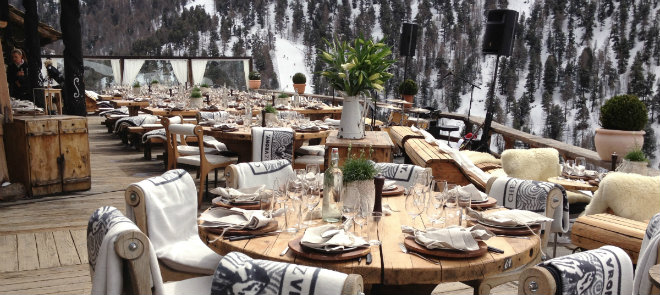
Back in Findeln again the very smart and renowned Chez Vrony delivers theclosest thing to haute cuisine on the mountain in Zermatt, as you will probably get, to its well-heeled clientele. Retaining all of its old hut character with tasteful furnishings (loads of wood and sheepskins), Chez Vrony is perhaps a more chi-chi version of Findlerhof. The cooking offers the same Valais product but with more international influences and is more fussily presented. This is accompanied as you would expect by a fine wine list. Chez Vrony is hard to beat anywhere in the Alps.
Tel: +41 27 967 25 52, Email: [email protected], Web: www.chezvrony.ch
Les Marmottes
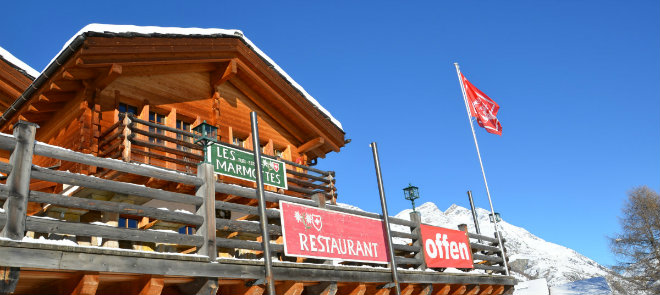
Nadine & Roby Perren have made Les Marmottes a top 10 mountain hut in Zermatt. This stylish Furi venue combines mountain charm and natural local farm produce and added an international and modern twist. Home made soups are followed for example by pasta dishes like linguini with king prawns flambé in vodka, oriental rice and noodles, a lamb curry or ( if you pre-order) Wagyu beef fillet. The local mountains are represented by dishes like venison in thyme sauce and chamois in cowberry sauce. The selection of game on offer also includes ibex, marmotte and roe deer. All in all quite amazing.
Tel: +41 27 967 82 82, Email: [email protected], Web: www.les-marmottes.ch
Stafelalp
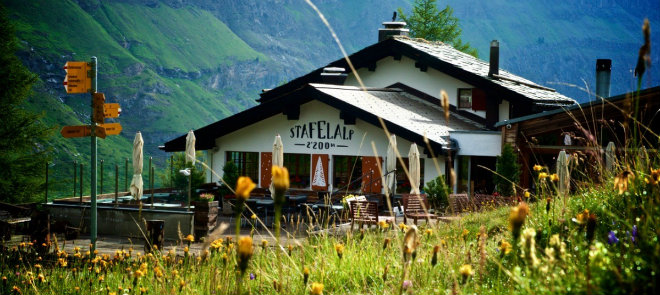
Relative newcomer on the block, straight into the top 10 and a welcome addition to lunching below Schwarzsee, this stunning hut is more like a large conservatory with timber floors and sheepskin furnishings. And lamb is quite a theme here as the indigenous black-nosed sheep pasture on the meadows nearby in summer. So with historic lamb cutlets, the Shafer-Pasta a variation of aglio e olio with finely sliced lamb’s tongues ( exquisite) and a homemade lamb kasebratwurst, Chef Hubert Konig redefines ovine experience here below the Matterhorn. If you are really hungry, you should also consider their hot stone dishes including Bison Rib-eye. And a selection of excellent Valais wines enlivens a competent wine list.
Tel: +41 27 967 30 62, Email: [email protected], Web: www.stafelalp.ch
Fluhalp
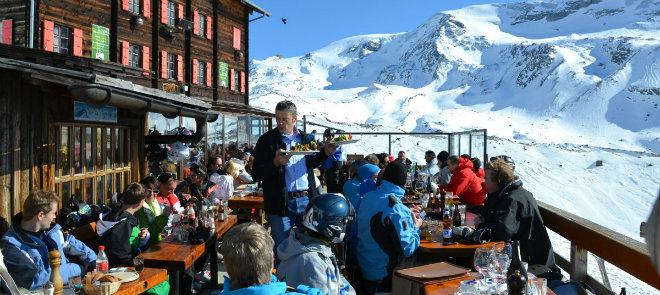
Only Zermatt offers so much choice above 3000m and Fluhalp is unmissable just below Unter Rothorn with its tall black timbered structure and red shutters. Famous for years for wonderful big Swiss cooking from homemade soups to pot au feu, bratwurst and pasta, what Fluhalp is really about is the live music and party atmosphere inside or out on the deck.
Tel: +41 27 967 25 97, Email: [email protected], Web: www.fluhalp.ch
Riffelalp Al Bosco
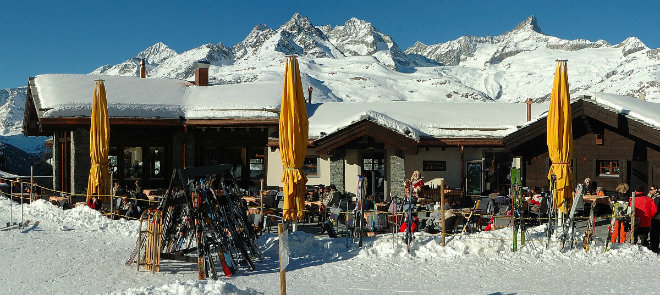
Part of the smart Riffelalp Resort at 2222m below Gornegrat, Al Bosco fills the geographical eating blank in this part of Zermatt’s range with fine Italian mountain food, including homemade pizzas! A modern timber clad room and wood burning stove add to the convivial lunchtime ambiance. Riffelalp is a beautiful setting in woods above Zermatt with its neighbouring station on the Gornergratbahn and Al Bosco finishes the picture.
Tel: +41 27 966 05 55, Email: [email protected], Web: http://zermatt.ch/riffelalp/d
Adler Hitta
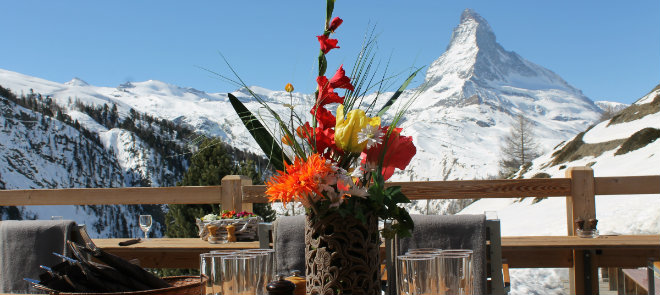
Back in Findeln, as if in need of more culinary excellence, the newly refurbished Adler hut has re-opened for business. The stunning refit still retains mountain roots with timber much in evidence but also with a refreshing modern cut, and another deck outside to sit and stare at the majestic Matterhorn from. Traditional Swiss/Italian mountain cooking is offered with some subtle variations (eg. homemade leek spatzli with bacon and penne with truffles and ceps). The ‘Eagle’ is an excellent mountain hut by any standards anywhere in the Alps.
Tel: +41 27 967 1058, Email: [email protected], Web: www.adler-hitta.ch
Simi
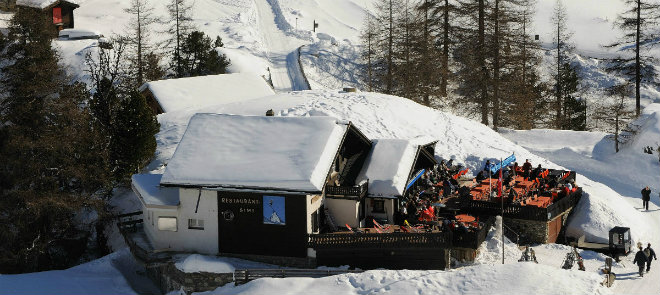
Opened in 1967 Simi’s is part of Zermatt legend. Situated in Furi at 1800m it has never stopped serving traditional Swiss and Walliser cooking and local Valais wines. A beautiful old hut and lovely terrace on which you can enjoy food cooked on the wood grill and also on hot stone. Simi’s is another Zermatt gem.
Tel: +41 27 967 26 95, Email: [email protected], Web: www.restaurantsimi.ch
Gandegghutte
There are not many places to choose from above 3000m on the Matterhorn Paradies side but the Gandegghutte above Trockener Steg has been a mountaineer’s refuge for over a 100years. Describing itself as an alpine cottage, it stands bleakly in winter on a rocky outcrop, with outstanding views, offering warmth and succour to skiers and mountaineers. Simple but excellent fare of smoked sausages, omelettes,pastas and kaseschnittes with a surprisingly good offering of mainly Valais wines but some Italian and even one Champagne typify Richard and Yvette Lehner-Gaudin’s list. Without electricity or water connection and supplied by helicopter and pistenbully, Gandegghutte is something of a miracleand is at the opposite end of the lunching spectrum from Chez Vrony. And it should be cherished for that.
Tel: +41 79 607 88 68, Email: [email protected]










